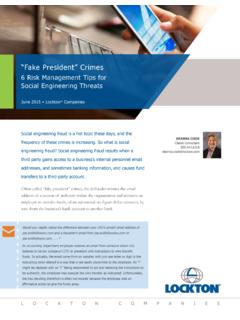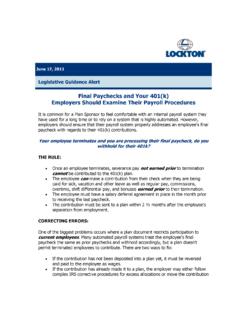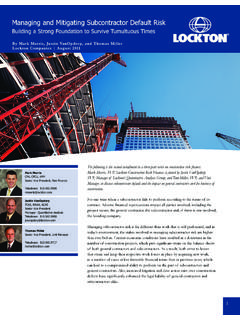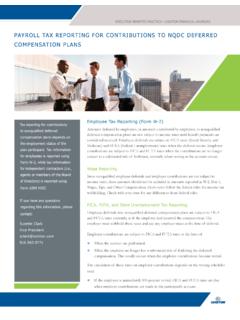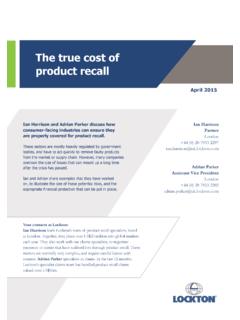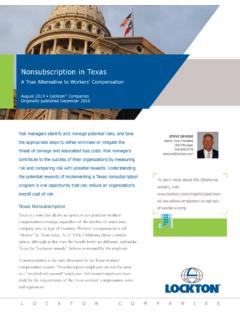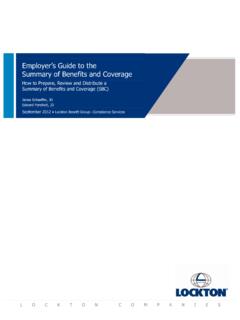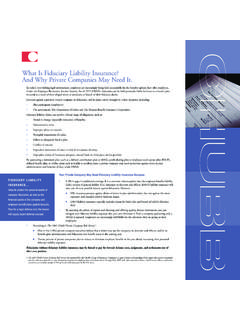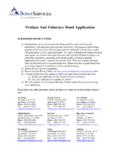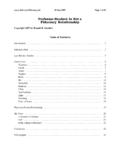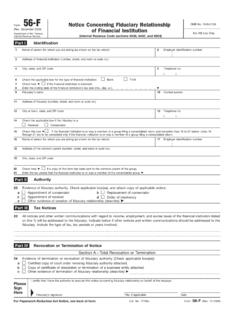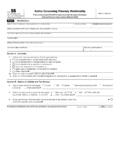Transcription of Fiduciary Liability Claim Trends - Lockton Companies
1 Fiduciary Liability Claim Trends Prepared by the Lockton Financial Services Claims Practice February 2017 Lockton Companies CLASS ACTIONS ALLEGING EXCESSIVE FEES PAID TO SERVICE PROVIDERS REMAIN. THE MARQUEE Fiduciary Liability RISK. Retirement plans are increasingly in the crosshairs for Plaintiffs are focusing on more than just corporate plans. plaintiffs' lawyers. Allegations of breach of Fiduciary duty based on payment of higher-than-reasonable Corporations are not alone in facing excessive-fee cases. fees to ERISA plan service providers are becoming A dozen prestigious universities have been sued by a more common. single law firm under the applicable ERISA section for including investment options that charge excessive In the past 18 months, at least 38 ERISA class fees. While those cases are in their very early stages, the actions have been filed. size of the 403(b) plans involved suggests that these Commentators have noted that the number of suits suits could also result in large settlements, which could filed over the past year and a half represents a surge encourage still more litigation in this area.
2 Over previous norms. This spike is partly driven by recent mega-settlements that have increasingly motivated Excessive fee class actions are expensive to defend. successful firms and encouraged copycats to bring similar suits. One insurer indicated that getting a case through the motion-to-dismiss stage costs between $500,000 and Smaller ERISA plans are now being targeted. $750,000. Moreover, due to the number of documents In the past, excessive-fee ERISA litigation targeted large involved and fact-intensive nature of these cases, plans with at least $2 billion in assets. More recently, completing discovery can cost between $ million and plans in the $500 million to $ billion range, and $5 million. some even smaller, have been sued. Once again, if the plaintiffs continue to be successful, even more suits can be expected. L O C K T O N C O M P A N I E S. February 2017 Lockton Companies The news isn't all bad. UNCERTAINTY CONCERNING NEW.
3 RULE EXPANDING DEFINITION OF. In White v. Chevron ( Cal. 2016), Chevron won its Fiduciary UNDER ERISA. motion to dismiss in a high-profile excessive-fee case against the leading plaintiff 's firm in this area. The The Trump administration has issued an order directing opinion was very defense-friendly and determined that the US Department of Labor (DOL) to review its the challenged selection of certain investment options new rule expanding the definition of who qualifies as by the plan fiduciaries was prudent. The opinion is a Fiduciary under ERISA. The new rule broadens the expected to support defendants across the universe of class of investment advisors who are ERISA fiduciaries these claims. and requires them to act in the client's best interests, reveal all conflicts of interests, and to more clearly The Fiduciary Liability insurance marketplace has disclose all fees and commissions. The rule has raised not changed much.
4 Fears that the new, more investor-friendly standard of The insurance marketplace has not yet reacted negatively care will lead to additional claims against investment to growth of excessive-fee litigation. Insurers continue advisors. Fortunately, such claims would be covered by to offer attractive pricing and retentions for most buyers. Fiduciary Liability , investment advisor, and other errors and omissions policies. Although the rule is scheduled to become effective on April 10, 2017, it is now likely that the rule will be delayed, and it may ultimately be revised or rescinded. 2. February 2017 Lockton Companies GROWTH OF ERISA STOCK-DROP LITIGATION. REMAINS FLAT, BUT COULD DECLINE IN THE FUTURE. The number of ERISA stock-drop suits filed per year has not grown in recent years. Those suits are filed by retirement plan participants against fiduciaries who elect to include shares of the company sponsoring the plan as an investment option.
5 Plaintiffs typically allege that the fiduciaries knew that the company's stock was a poor investment but that they included it anyway. Approximately 70 percent of ERISA stock-drop cases are filed following a related securities class action. Although settlements of those ERISA cases are typically less than the related securities class actions, the amounts are often large. According to Cornerstone Research, for suits filed between 1997 and 2014, the median settlement for ERISA stock-drop matters is $ million, with the average settlement about $ million. The number of ERISA stock-drop suits may decline because of a very recent decision of the US Supreme Court. On January 25, 2017, in Amgen v. Harris, the Court decided that a stock-drop suit is vulnerable to dismissal if the plan fiduciaries might have done more harm than good by eliminating the stock as an investment option. An example of such harm would be the effect on the stock price if the stock is removed from the plan and participants and other investors begin to sell it, thinking that it is no longer a good investment.
6 Some speculate that it may prove difficult for plaintiffs in many cases to overcome this hurdle and it may lead to fewer suits being filed as a result. RECOVERIES BY THE EMPLOYMENT BENEFIT SECURITY. ADMINISTRATION. The Employment Benefit Security Administration (EBSA) is responsible for securing the integrity of private employee benefit plan systems. During 2015, the EBSA recovered nearly $700 million on behalf of plans and participants. The EBSA achieved monetary recoveries and other corrective actions in 67 percent of its civil investigations. And the EBSA closed 275 criminal investigations, 67 of them with guilty pleas or convictions, and indicted 61 individuals. 3. February 2017 Lockton Companies LEGAL DEVELOPMENTS. When does a breach of Fiduciary duty Claim under ERISA accrue? In 2015, the US Supreme Court decided in Tibble v. Edison International that ERISA plan fiduciaries have a continuing duty to monitor trust investments and remove imprudent ones and that a plan participant can bring a Claim within six years of any failure to monitor.
7 The case was remanded to the trial court to determine if a review of investment options added more than six years before the suit was filed was required. Commentators feared a ruling that plaintiffs could use to defeat motions to dismiss as well as bring new ERISA cases that were previously believed to be time- barred. But the Ninth Circuit dismissed the matter again without addressing the issue, leaving the question of review unanswered. For the near term, the trigger for when an ERISA Claim accrues will remain unchanged. Who qualifies for the church plan exemption to ERISA? The US Supreme Court agreed to hear three consolidated cases from different Circuits concerning the church plan exemption to ERISA. The IRS has taken the position that church-affiliated plan sponsors often healthcare systems are captured by this exclusion and not subject to ERISA's requirements. The Third, Seventh, and Ninth Circuits disagreed, saying that the plan must be maintained by a church or association of churches to qualify for the exemption.
8 If the Circuit rulings are affirmed, a host of plans will be subject to ERISA and associated claims. Experts fear that if these rulings are upheld, there will be an influx of new claims that could result in billions of dollars of Liability . Can an ERISA plan recover settlement monies in a securities class action? Retirement plans that hold their sponsoring company's stock are often some of the company's largest shareholders. If a shareholder brings a securities class action, the retirement plan may be able to benefit from any settlement reached. Class action settlements typically exclude affiliates of the company being sued. Consequently, a plan's ability to participate in the settlement depends on whether it is considered to be an affiliate of the sponsoring company. In American International Group, Inc. Securities Litigation, 2016 WL 5075939 (2nd Cir. Sept. 20, 2016), the Second Circuit decided that AIG retirement plans were not affiliates of AIG and that they could, therefore, receive their share of a shareholder class action settlement.
9 The decision conflicts with a Seventh Circuit case, which could ultimately result in the question being decided by the US Supreme Court. In the interim, it will be interesting to see whether recoveries by a plan impact the incentive that plan participants have to bring claims alleging that plan fiduciaries acted imprudently by including company stock as an investment option. 4. February 2017 Lockton Companies NOTA B L E S ETT LEMEN TS. $57. $75 million million $352 million $156 million $40. million $82 million $140 million $62 million $90 million $107 million $352 million settlement in Washington by Providence Other Settlements Health Services for alleged ERISA violations related to the $36 million settlement by Northern Trust Investments arising church plan exemption. (2016). from alleged imprudent management of collateral pools in its $156 million settlement in Mississippi by Singing River securities lending program. (2015).
10 Health Services for alleged ERISA violations related to annual $33 million settlement by Freight Car America arising from required contributions to the plan. (2016). termination of union workers' retiree health and life insurance $140 million settlement by Nationwide Life Insurance benefits. (2015). arising from allegedly receiving undisclosed revenue-sharing $30 million settlement by International Paper arising from payments from nonproprietary mutual funds. (2015). alleged excessive fees and improper revenue sharing. (2013). $107 million settlement in Connecticut by Saint Francis $ million settlement by Ameriprise Financial arising Hospital for alleged plan mismanagement. (2016). from alleged self-dealing and other breaches of Fiduciary $90 million settlement by Boeing arising from alleged duties. (2015). deprivation of benefits after sale of Spirit Aero Systems $ million settlement in Utah by Larsen, Inc., for alleged business unit.

